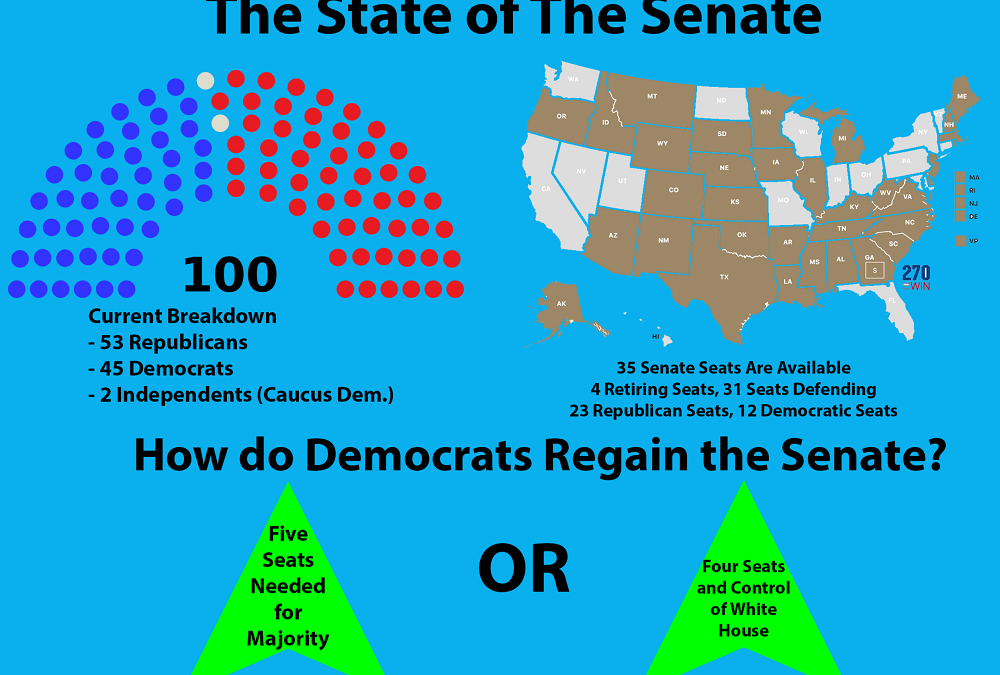WASHINGTON — The Nov. 3 election will not only decide who is the next president, but whether Republicans continue to control the Senate, with 35 seats up for grabs. Twenty-five are held by Republicans, five of whom are in close races whose results could hand control of the Senate to Democrats.
Currently, there are 53 Republican senators, 45 Democrats and two Independents. However, control of the Senate could flip if GOP incumbents lose in extremely close races in Arizona, Colorado, Iowa, Maine and North Carolina.
J. Miles Coleman, associate editor for the University of Virginia’s Center for Politics, describes four of these races – excluding Colorado — as “the core four.”
“These are four seats that the that the Democrats could flip,” said Coleman. “And if they flip these and if [former Vice President and Democratic presidential nominee Joe] Biden wins, they’ll get to 50/50.” If Biden wins, his running mate – California Sen. Kamala Harris — would also be Senate president and have the tie-breaking vote.
One of the most vulnerable Republican incumbents is Maine Sen. Susan Collins, who is running against state House Speaker Sara Gideon. Collins, a six-term senator, has been criticized for voting to confirm Supreme Court Justice Brett Kavanaugh.
Professor Amy Fried of the University of Maine explained that Collins had been a popular figure in Maine politics but her recent decisions to follow President Donald Trump’s wishes have hurt her.
“She was able to burnish her centrist image through a series of endorsements, such as from pro-choice groups, and environmental groups, and also from some labor groups,” Fried said. “And she’s lost those endorsements now.”
Similarly, incumbent Iowa Sen. Joni Ernst is facing a strong opposition from Democratic businesswoman Theresa Greenfield, and her reelection is tied to the popularity of where her fate is tied to Trump.
“I think … the key to this election is if Trump can do a few percentage points better than he’s doing now, then Ernst will win,” said Professor Arthur Sanders of Drake University. “If he sinks as he’s been sinking even further, then Greenfield is going to win.”
Others like Coleman look towards North Carolina as particularly vulnerable. Republican incumbent Sen. Thom Tillis is defending his seat against Cal Cunningham, a former state senator and Army Reserve officer. Coleman describes Tillis, who won his first term in the 2014 midterm election in which Republicans regained control of the Senate, as a not particularly strong candidate. Cunningham leads in the polls, despite revelations of an extramarital relationship.
“We still have that race as toss-up. But (Tillis is) been down in those polls,” said Coleman. “We’re sort of giving him the benefit of the doubt because it’s easy to see Trump carry North Carolina by maybe a point or two.”
In Colorado and Arizona, Democrats are optimistic about their Senate races will be Democratic gains for the Senate, according to Don Levy, director of the Siena College Research Institute.
In Colorado, according to a recent SurveyUSA/KUSA-TV poll, former Colorado Gov. John Hickenlooper leads incumbent Republican Sen. Cory Gardner by nine percentage points.
Professor Dominik Stecula of Colorado State University said that is one of the seats most likely to be a Democratic gain.
In Arizona, according to the Siena College/New York Times Poll, Democratic Senate nominee and husband of former Rep. Gabrielle Giffords Mark Kelly leads incumbent Sen. Martha McSally by 11 percentage points. Levy said that Kelly is gaining among independent voters in the state as well as some Republicans.
While these five seats are the most prominent, Levy said that there are more states that could be in play.
“We have a new fascination with the South Carolina race, poll after poll was coming out with [Jaime] Harrison and [incumbent GOP Sen. Lindsay] Graham, extensively dead even,” he said. “And surprisingly, we’re even talking about Georgia and Texas.”

